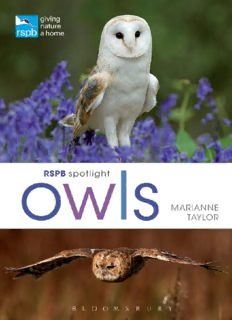
RSPB Spotlight: Owls PDF
Preview RSPB Spotlight: Owls
For all items sold, Bloomsbury Publishing will donate a minimum of 2% of the publisher’s receipts from sales of licensed titles to RSPB Sales Ltd, the trading subsidiary of the RSPB. Subsequent sellers of this book are not commercial participators for the purpose of Part II of the Charities Act 1992. Contents Meet the Owls Anatomy and Adaptations Behaviour Territory, Competition and Migration Diet and Hunting Pairing and Breeding Life and Death Owl Conservation Owls in Culture Glossary Further Reading and Resources Acknowledgements Image Credits The ethereal beauty of the Snowy Owl. Meet the Owls A haunting, fluted hoot that jolts you out of sleep at 4am. A white ghost freeze-framed in your headlights on a dusk drive home in winter. A furious little face staring at you from the crack in an old barn roof. Encounters with owls in Britain are often startling and always memorable. Few other birds evoke such a strong sense of magic and mystery and – if you meet their gaze – understanding and connection, or at least the illusion of such. It’s almost impossible to look at the face of an owl and not attribute some human quality to its expression. Secret lives Wherever we live on the planet, almost all of us know an owl when we see one; its forward-facing eyes seem to burn into our own. Centuries of fanciful folklore have bumped owls higher up in our cultural consciousness than perhaps any other birds, even though most of us only see owls infrequently in our everyday lives, if at all. The nocturnal habits and deep forest habitats of some owls, coupled with predatory powers that seem to almost defy nature and a repertoire of haunting and frightening calls, endow them with a mystique as irresistible as it is potent. A Tawny Owl sitting at its tree-hole nest is the very image of a 'wise old owl' of the woods. In this age of television, YouTube and Facebook, we now have opportunities to see owls in action in different settings, without having to take a midnight walk in the woods. Through skilled camerawork we can see for ourselves how owls use their remarkable senses to find and catch their prey, overcoming challenging conditions that most other animals would find impossible to handle. We can also watch rescued or trained captive-bred birds interacting with their keepers, revealing depths of charm, adventurousness and intelligence that vastly add to their appeal. Yet the day-to-day lives of wild owls remain rather mysterious, though our knowledge and understanding of them is growing by the day. Short-eared Owls seem to be more sociable than most other species, but this behaviour is still not well understood. In Britain, there are five species of owls regularly breeding in any numbers. That’s a tiny proportion of the world total of more than 200 species. However, these five owls are quite a diverse bunch, in size, shape, colour, habits and personality. In short, they demonstrate five very different ways to be an owl. In addition to these five, a few other species (again, all very different) make occasional ‘guest appearances’ in the wild in Britain. File under ‘O’ The term ‘bird of prey’ denotes a bird that hunts and eats other vertebrate animals. Many birds, from rails to herons and gamebirds to songbirds, may do this from time to time. However, the title of ‘bird of prey’
Description: